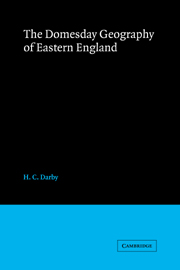Book contents
- Frontmatter
- Contents
- Preface
- NOTE TO THIRD EDITION
- List of Maps
- Chapter I THE DOMESDAY BOOK
- Chapter II LINCOLNSHIRE
- Chapter III NORFOLK
- Chapter IV SUFFOLK
- Chapter V ESSEX
- Chapter VI CAMBRIDGESHIRE
- Chapter VII HUNTINGDONSHIRE
- Chapter VIII THE EASTERN COUNTIES
- Appendix I Summary of Domesday Book for the Eastern Counties
- Appendix II Extension and Translation of Frontispiece
- Index
Chapter VII - HUNTINGDONSHIRE
Published online by Cambridge University Press: 05 November 2011
- Frontmatter
- Contents
- Preface
- NOTE TO THIRD EDITION
- List of Maps
- Chapter I THE DOMESDAY BOOK
- Chapter II LINCOLNSHIRE
- Chapter III NORFOLK
- Chapter IV SUFFOLK
- Chapter V ESSEX
- Chapter VI CAMBRIDGESHIRE
- Chapter VII HUNTINGDONSHIRE
- Chapter VIII THE EASTERN COUNTIES
- Appendix I Summary of Domesday Book for the Eastern Counties
- Appendix II Extension and Translation of Frontispiece
- Index
Summary
The Huntingdonshire folios raise few points that are of unusual interest in a geographical analysis of the Domesday Book. The county is a small one, and the entries, as Domesday entries go, seem relatively straightforward. It is true that a special feature of the Domesday description of the county is the presence of what amounts to an appendix dealing with matters in dispute. This is of great concern to students of law and administration, and has been discussed by Sir Frank Stenton, but it adds nothing to a picture of the Huntingdonshire countryside in the eleventh century. Parts of the county were held by the abbey of Ely, and these holdings accordingly appear in the Inquisitio Eliensis (pp. 166–7) in a somewhat more detailed form than in the Domesday Book itself. The holdings comprised the four manors of Bluntisham, Colne, Somersham and Spaldwick, together with the berewicks of Stow, Easton, Barham and Little Catworth belonging to Spaldwick. This limited material does not provide opportunity for extensive comparison, but it does provide some extremely interesting information that is discussed in the relevant sections below.
There is one complication, however, that must be mentioned. The modern county of Huntingdon does not correspond exactly with the area described in the Huntingdonshire folios. The Northamptonshire villages of Hargrave, Lutton, Luddington and Thurning are described partly under Northamptonshire and partly under Huntingdonshire; the last three still straddled the county boundary in the nineteenth century.
- Type
- Chapter
- Information
- The Domesday Geography of Eastern England , pp. 315 - 349Publisher: Cambridge University PressPrint publication year: 1972

